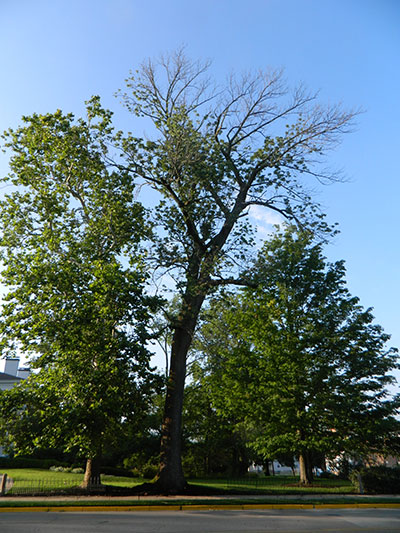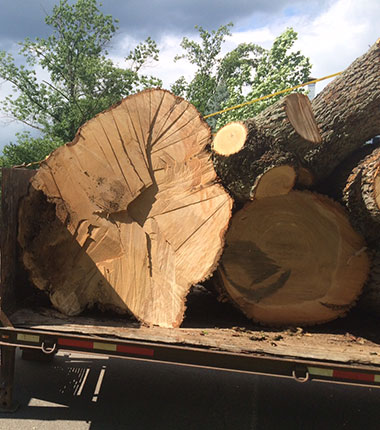
Insects strike some of Miami's beloved trees: Removal underway
Our Campus Beauty

The ash tree at Lewis Place was one infested with the Emerald Ash Borer.
by Vincent Cirrito, landscape architect, physical facilities
The end of summer 2015 signals the start of additional tree removals of dead and declining trees across campus. Go ahead. Blame the ash borer.
The ash trees at Miami make up the majority of trees that must come down. The Emerald Ash Borer devastated many trees across the Midwest and North East regions. The borer, an ash tree-killing invasive insect from Asia, was first identified in 2002 in southeast Michigan and Windsor, Ontario. The borer, during the larvae stage, destroys the water and nutrient conducting tissues under the bark of the ash tree. This results first in dieback of the upper canopy and eventually death to the tree.
The insect made its first appearance in Butler County in 2007. Miami’s staff arborist Fred Rader began treating Miami’s ash trees with soil-applied insecticide known as the “soil drench” method. This method worked well as it was rather simple. The insecticide product mixed with water, and the solution was poured directly on the soil around the base of the trunk. Our crews were able to treat almost every ash tree on campus with this method on a yearly basis with much success.

The ash tree at Lewis Place at almost 6 feet in diameter is calculated at about 160 years old.
Unfortunately upon recent evaluation, it has become apparent that the soil-applied insecticide is no longer effective in the management of the pest as it fully infests area trees. In response to this finding, Miami hosted the city of Oxford and other interested parties of the region last fall for an information session provided by a local community member.
An injection-type method was demonstrated utilizing an insecticide proven in industry trial studies as one of the most effective treatments on the market today. It kills the larvae of the Emerald Ash Borer before damage to the tree.
Since more time-consuming and a greater expense, Miami selected only those trees that are prominent in our landscape or of other importance to receive this treatment. However, even with treatment last fall, we have had to remove two of our largest ash trees on campus this summer at Lewis Place and near Roudebush Hall.
Another pest, the Asian Long Horn Beetle, could have other devastating effects on our tree canopy. Unlike the Emerald Ash Borer, the Asian Long Horn Beetle can damage and kill multiple tree species including the maple, birch, Ohio buckeye, and horse chestnut. This bug has now been spotted in Ohio as close to campus as Clermont County.
It’s not only the bug’s fault
Last fall, some 120 trees were removed mostly consisting of ash trees. This fall we are currently contracted for the removal of an additional 100 trees. Tree death sometimes cannot always be attributed to bug infestation. Some of the recent tree deaths are due to ongoing soil compaction from our high traffic areas or the lasting effects from the drought that began in late summer 2007 through the fall of that same year.
Look for my column, Our Campus Beauty, in October. I’ll explain our tree replanting program.
Our Campus Beauty appears each month in Miami Matters.
